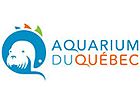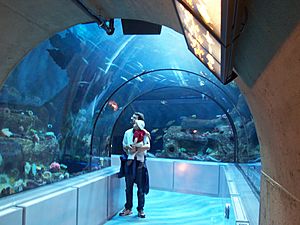Aquarium du Québec facts for kids
 |
|

The main building, the stream and part of the garden.
|
|
| Date opened | 1959 |
|---|---|
| Location | 1675, avenue des Hôtels Quebec City, Quebec G1W 4S3 |
| Land area | 16 hectares (40 acres) |
| Coordinates | 46°45′03″N 71°17′18″W / 46.7508°N 71.2884°W |
| No. of animals | 10,000 |
| No. of species | 300 |
| Volume of largest tank | 350,000 litres (92,000 US gal) |
| Memberships | CAZA |
The Aquarium du Québec is a super cool public aquarium in Quebec City, Quebec, Canada. It's like a giant underwater world! This amazing place covers 16 hectares (about 40 acres). It's home to over 10,000 animals, with more than 300 different kinds of species. Imagine all those fish, seals, and even polar bears! The Aquarium du Québec is run by a group called Sépaq. It's also a proud member of the Canadian Association of Zoos and Aquariums (CAZA).
Contents
History
How the Aquarium Started
The idea for the Aquarium du Québec began in 1953. A scientist named Dr. Vadim D. Vladykov wanted to create a special place. He convinced Dr. Arthur Labrie to get land near the Quebec Bridge. The government bought the land in 1954. Building work started in 1955.
In 1956, the Biological Centre of Quebec opened. It had labs for marine biology research. It also had two sets of aquariums. Soon, more labs were added to study fish like salmon and lobster. They even had a big library. The aquarium used 230,000 gallons of fresh water from Lake Saint-Charles. Saltwater, about 320,000 gallons, came all the way from Rimouski!
Opening to the Public
In 1959, the aquarium opened to the public. It was first called the Organic Centre. It had new areas for visitors and a restaurant. The centre wanted to teach people about marine life. They even started a special program for children. This was a first for a museum in Quebec! In its first year, 150,000 people visited. This led to more outdoor pools for seals and more aquariums.
Becoming the Aquarium du Québec
By 1971, the research scientists moved to a new building. The aquarium then changed its name to the Aquarium du Québec. This showed that it was now a place for public education. But don't worry, research still happens there with universities!
In 1999, the aquarium welcomed its eight-millionth visitor. But the buildings were getting old. The government decided to let Sépaq manage and update the aquarium.
Big Renovations and New Animals
After two years of being closed for updates, the new Parc Aquarium du Québec reopened in 2002. The main building, gardens, and seal pools were all made new. Many international animals were replaced with aquatic species from Quebec. A cool new polar bear exhibit was added. It even had an underwater viewing area!
In 2005, the government decided to invest more money. They put $6.5 million into the aquarium. This helped them expand their collection of animals. In November 2008, the place officially went back to being called Aquarium du Québec. They even got a new logo!
Attractions
The Aquarium du Québec has lots of fun things to see! It has beautiful gardens and several outdoor pools. The main building is full of exciting exhibits. Every year, they also have a special Light Festival called Festi Lumière. They light up the place with over 50,000 LED lights for the holidays!
The aquarium is home to about 10,000 animals. These animals represent around 300 different species. You can see fish, crabs, snails, turtles, frogs, birds, and marine mammals. The Aquarium du Québec is special because it focuses on animals from cold places. These include animals from boreal (northern forest) and arctic areas.
The Aquarium du Québec has seven main exhibit areas. Each area shows the wildlife and nature from a specific part of the world.
Indoors
The Awesome Ocean
This is the main highlight of the aquarium! You get to walk through a tunnel inside a huge 350,000-liter (about 92,000-gallon) saltwater tank. It feels like you're a diver exploring the ocean! You can see all sorts of marine life swimming around you. Sometimes, real divers are in the tank to show off the animals.
Discover the Coastal Zone
This area shows you the world of marine invertebrates from Canada's Atlantic and Pacific coasts. Invertebrates are animals without backbones. Here, you can even touch some of the animals! Imagine feeling a starfish, sea urchin, hermit crab, or sea cucumber. It's a hands-on adventure!
Fresh & Salt Water
On two levels, these aquariums show life where fresh river water meets salty ocean water. This happens in the Saint Lawrence River basin. You can see how different animals live in these mixed water environments.
Scientific Crossroads
Want to know how scientists study marine life? This section is for you! You can learn about the important research done at the Aquarium du Québec. Discover more about marine labs and how scientists help protect ocean animals.
Outdoors
Wetlands
This exhibit shows the amazing ecosystem of the St. Lawrence corridor. You'll see many birds, amphibians, insects, reptiles, and plants. These are all animals and plants that live in the wet, marshy areas around the river.
Banks of the St. Lawrence River
As you look out over the mighty St. Lawrence River, you can watch the seals! Grey seals and harbour seals love to play and swim in these pools. It's fun to see them frolic in the water.
The Arctic Sector
Step into the Arctic world! Here, you can see animals that live in very cold places. Look for harp seals, walruses, and polar bears. You can even see them underwater through a glass view! The exhibit shows how these animals live through all four seasons. The aquarium is proud to be the first and only place to care for two different kinds of walruses. They even have a daily walrus show!
Images for kids
See also
 In Spanish: Acuario de Quebec para niños
In Spanish: Acuario de Quebec para niños



